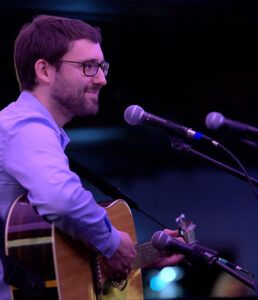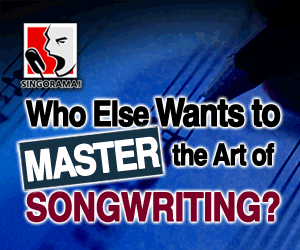Let’s face it: You’ve probably tried a LOT of typical songwriting exercises before… “set a timer,” “replace the lyrics to another song,” or even just “listen to a song you like.”
And I’m not going to lie – those can be really helpful!
But when you’re looking to break new creative ground, you need something totally NEW to help you escape conventional thinking and take your songwriting skills to new heights. That’s where I can help!
As a songwriter for more than 10 years, I’ve experienced periods of creative abundance, but I’ve also experienced periods of crushing songwriters block. It was for those times when I had ZERO good ideas that I actually invented some unique ways to get the creative juices flowing again.
Here are 13 unconventional songwriting exercises I’ve used to take my songwriting skills to the next level. Hopefully, they can do the same for you!
Improve your songwriting by mastering piano.
$49
ONLY
1. Play a brand-new instrument (or none at all).
Yep! The average songwriter typically has a go-to type of instrument for writing songs. As an example, my brother Daniel used to only be able to write songs on guitar – now he’s comfortable with both piano and guitar, but he still finds guitar easier.
If you usually write songs on acoustic guitar, try piano. If you prefer piano, try the ukulele. Or the bass. Or the drums. If you’ve written great songs with conventional instruments, why not start writing new songs with something a little “out there,” like a flute, harmonica, xylophone, bongos, or kazoo?
You don’t have to be an expert to come up with interesting new ideas on an unfamiliar instrument. In fact, you don’t even need an instrument AT ALL – you could mess around inside of your DAW using loops or the piano roll to see what intriguing new sounds, rhythms, and hooks you can come up with.
The point is, you’re giving yourself the chance to hear new sounds and feel your way through an instrument that you don’t already have unconscious patterns of playing in. This can help you discover the perfect sound to complete your next hit single.
2. Choose a favorite song and write your own response to it.
There’s another side to every story. Does “Empire State of Mind” appeal to you? What would response to this song be as a proud citizen of another locale? Could you make a song that tells Jay-Z and Alicia Keys what YOU think of their favorite state?
Or instead of a “response,” what would a continuation of that idea be, as a fellow New Yorker? Has New York City gotten even better or has it gone downhill since “Empire State of Mind” came out? There are LOTS of potential ways to get inspired by it if you think of your song as the next step in a larger conversation.
You can do this with most types of songs. For instance, if it’s a story song, you could write its “sequel.” What happens after Billy Joel’s “Piano Man?” You don’t have to make it literally a sequel to someone else’s song, either. You can simply have your protagonist be inspired by the events of another track.
Another approach is to take a popular music track and choose a new narrator or POV. What if “Every Breath You Take” was written from the perspective of the girl being “watched?”

The idea here is to consider that there’s more than one way to explore any idea. If there’s a song you love, there’s probably still untapped potential hidden between the lines. Piggybacking off of someone else’s song topics can open up fascinating new possibilities for a new idea of your own!
3. Pick a random phrase from the book that’s closest to you.
Whatever you see, make that the idea for your next song. In fact, you could even take a phrase from this article!
(I’ll even try to leave some poetic phrases to make things easier for you, dear reader… Like the clean, soft hands of a masseuse, I’ve got your back.)
And if you find random phrases to be too strenuous, consider using a favorite symbol from literature. It’s been done before, but it’s always a good way to get inspired quickly.
4. Improvise 3-5 melodies over a jam track.
Try to come up with a handful of completely different melodies over the exact same chord progression (if you need help with writing some power chords, I’ve got you covered). The goal here is to see how you can get lots of outcomes out of the same starting conditions. Switch up the notes, rhythms, and feel of each of your attempts.
If it goes well, you should have a number of different melody options you can rank and select from. You might even have a couple parts that you can use in the same song – use one as your verse and one as your bridge.
If you use a preexisting jam track that’s not yours, you can always change the backing track later. It’s sort of like the Ship of Theseus (I’ll let Vision explain):
5. Use flash cards to brainstorm a new songwriting topic.
Take 15 minutes to put words and phrases that seem interesting onto 99 index cards, divided across these three categories:
- Adjectives
- Nouns
- Verbs
Shuffle the cards. Then, flip over three cards and brainstorm a song topic that combines or incorporates all three.
Not sure which words to use on the flash cards? First, do a free write session and write down anything that pops into your head. Try to think abstractly and not be limited to the physical things sitting in your room. Then, transfer all those words to the flash cards. With any luck, you’ll find some unexpected combinations and can fully pursue whatever ideas they spark.
If you’ve tried your best and still don’t like the combination you got, no sweat! Just flip over another three cards. The best part is you can keep the deck of cards for your next songwriting session and break them out whenever you need some sudden inspiration. It works great as a songwriting warm-up exercise, too.
6. Do speed dating, but for songs.
You know how speed dating involves getting to know someone for just a few minutes and seeing if you hit it off? Then, it’s onto the next one?
Rather than trying to write one song from start to finish, try setting a timer for 3, 5, or 10 minutes and brainstorm a handful of new song ideas. Then, reset the timer again and work on one of the ideas for the duration of the timer.
Repeat for each idea. At the end of this working session, you’ll have several fleshed-out ideas and you can decide if any are worth returning to (for a real “date”).
This is a great way to get some headway into a number of ideas that you only feel lukewarm about. If you’re struggling to get a song anywhere during its allotted time, keep going! On the other hand, if you’re doing really well with a song and find yourself ‘in the zone’ even as time runs out, perhaps stick with it a while longer.
That judgment call is up to you, but if inspiration has come knocking, don’t let me be the one to tell you to turn it away!
7. Create a song parody.
You’ve come here for a songwriting challenge – get in the head of an artist you like (or one you can’t stand). Parody one of their songs. This will force you to get a feel for the way their song works at a molecular level while also giving you a chance to express ample creativity.
Will you write your lyrics about something unrelated, or about the original artist and song themselves? The king of parodies for the last four decades is “Weird Al” Yankovic, and he’s done some of each. He even makes a habit of making “style parodies” of artists and genres, where no specific song’s music is used, but the influence is abundantly clear. He does this by meticulously studying a band’s discography and composing something that reflects quintessential elements of that band’s oeuvre.
It’s up to you if you’ll take things that far, but I highly recommend trying to study the artist you parody. There’s no better way to walk a mile in an artist’s shoes than to try to study and parody their work.
8. Just make a poem.
Start by divorcing music from the equation completely. Just write a free verse or rhyming poem with imagery, sounds, and concepts that you like – and then, once it stands on its own as a poem, you can think about music for it.
Many songs come from poems. Have you heard Auld Lang Syne sung on New Years Eve? That’s a poem by Robert Burns.
Even non-rhyming poems can becomes songs. Famously, Sheryl Crow’s “All I Wanna Do” borrows from a poem by Wyn Cooper. If Sheryl Crow can build a career adapting poetry to song, why can’t you?

9. Put on your “instrumental songwriters” hat.
Start by throwing out any ideas for lyrics or even what the song’s topic should be. Just sit down at your instrument or DAW and focus on making music. Follow your intuition to find interesting melodic and chord ideas.
Once you have an instrumental song that stands on its own, then – and ONLY then – can you start to think about the song’s theme and add words.
One reason this exercise works well is that the best lyrics are those that match the music exactly. If your music already is completed, you will have a strong feeling for what the song represents. You will be able to sense if the lyrics you’re writing appropriately fit, or if they haven’t quite met the mark yet.
Plus, you might even find that you like your instrumental enough you don’t want to add words.
10. Embrace paradoxes.
Make a country song about living in the city. Sing the blues about winning the lottery. Write a love song to your worst enemy – or if you want a real challenge, write a break-up song addressed to the current love of your life.

Self-imposed parameters like these can push you to be more creative than you would be otherwise. And even if it doesn’t totally work, you can’t say it isn’t more interesting than yet another love song to add to the pile.
This is a great song exercise even if you have lots of ideas. Paradoxes, oxymorons, and contradictions keep listeners on their toes and add depth to any song. It’d be awfully good of you to include some!
11. Domo arigato, Mr. Roboto.
If you follow music or tech circles, you probably know that every few months a new song created by AI comes out. Whether it’s a supposedly new song from Nirvana or a new way to generate lyrics, AI is slowly but surely working its way into the music space.
For instance, I tried an AI generator and told it I wanted a happy pop song that uses the word “miracle.” Here’s the first two lines it gave me:
“One word and you can bring a miracle
One kiss and you know I can bring a miracle”
Whether it’s brilliant or not, it’s definitely passable and a pretty great place to start if you’re short on ideas.
So, if you can’t beat ’em, join ’em. Let one of the many AI lyric generators create a line that you can write a song around. Or pretend you’re the AI and try to synthesize a genre or artist you’ve chosen.
What would an AI notice about it if it were trained to make songs that sound like that subject? Do it yourself and see if you can “beat” the computer.
12. Look twice, write once.
Instead of sitting on your couch with a guitar and a laptop, take a walk and look around. Immerse yourself in nature or go to a crowded center for people-watching. Wherever you choose to be, take long looks and note every detail you can.
Other songwriters embrace this approach. For example, Jay-Z played an observation game like that with his father. It taught him not just to look, but also to really see his surroundings. It’s a good skill for a songwriter to have. If you want to perfectly capture people, places, and things in song, you’ll need to be able to find subtle details and use them to tell a bigger story.
That’s called synecdoche. It’s like when you refer to “boots on the ground” – the soldiers are represented by the boots. For a song example, look to Fun.’s “We Are Young” when he says “My seat’s been taken by some sunglasses asking ’bout a scar.”
If you can get across an entire backstory of a person with a single word, you’ve mastered observation.
13. Listen for “music” in nature.
Using your eyes for song inspiration isn’t the only good sense-based exercise – you can also use your ears. Go somewhere – anywhere – and sit quietly.
Now, listen for the rhythmic patterns around you. Rain tapping on some sheet metal outside, the hum of your refrigerator, your own teeth grinding away with impatience over sitting still for a few minutes… whatever sound you hear, make a song around it.
There are so many exciting sounds that you can use to get started. If you have perfect pitch, you might have an easier time hearing notes out of random environmental sounds. But even if you can’t identify the pitch, the patterns and tone should be enough to get you started.

Remember, much of the best music of all time was written to evoke the settings the composer had in mind. For instance, Antonio Vivaldi’s “The Four Seasons” evokes each of the seasons of the year.
What can you take from your environment and immortalize in a song?
Creative Songwriting Exercises Wrap-up
There’s no one “right” way to write a song. On the other hand, the only “wrong” way is to not write one at all! If any of the above song exercises help you to write something, anything, then this post has been a success.
Remember that not every songwriting exercise has to lead to a masterpiece. Songwriting is a skill that requires practice. If writing a weird song inspired by an AI lyric generator or flashcards helps you get faster or better at writing songs, there’s no problem setting aside the song after the fact. You still got something out of it.
And if it DOES lead to a brilliant song, or at least leads to an awesome new riff or cool line, that’s just the cherry on top!
Good luck with going through these songwriting exercises. If you need to try these exercises over time, feel free to bookmark this page.
If you want to get better at writing memorable music that resonates, I recommend that you get familiar with an instrument like piano. The more you know about how great songs are constructed sonically, the easier it will be for you to create a masterpiece yourself. Check out Piano for All below to get started!
Improve your songwriting by mastering piano.
$49
ONLY

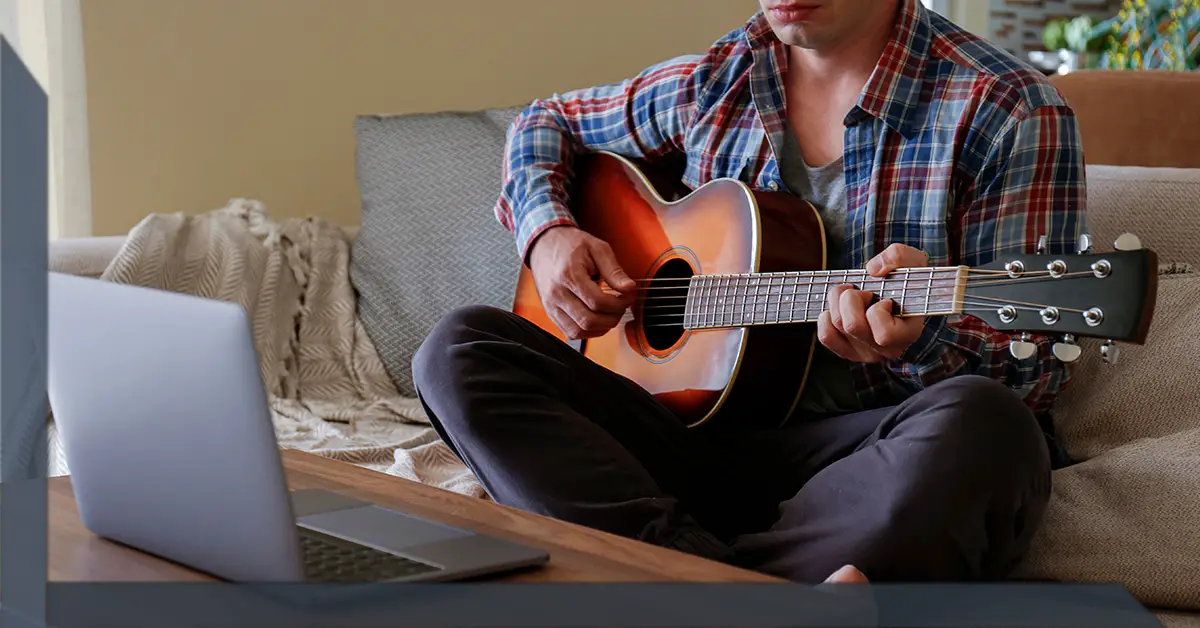
![Get Rid of Songwriters Block [With 5 Songwriting Exercises!]](https://improvesongwriting.com/wp-content/uploads/2021/09/How-to-Get-Rid-of-Songwriters-Block-440x264.jpg)
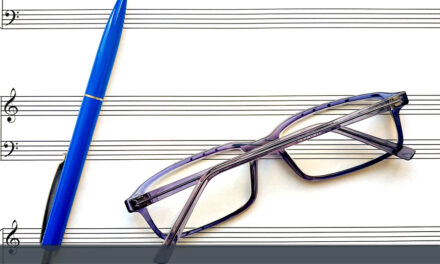
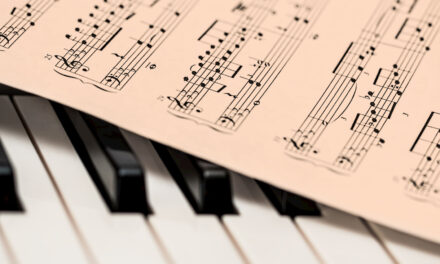
![Why is Songwriting So Hard? [The 3 Top Reasons]](https://improvesongwriting.com/wp-content/uploads/2019/09/Why-is-songwriting-so-hard-440x264.jpg)
